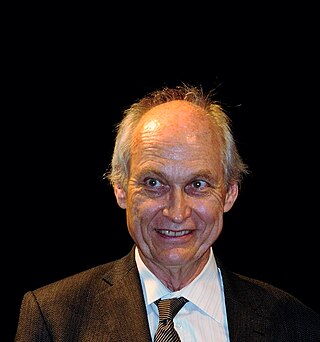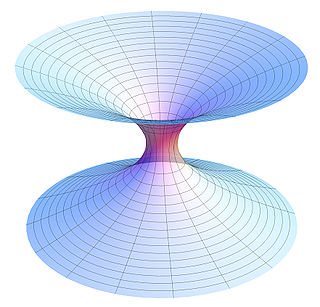Related Research Articles

In cosmology, the cosmological constant, alternatively called Einstein's cosmological constant, is the constant coefficient of a term that Albert Einstein temporarily added to his field equations of general relativity. He later removed it. Much later it was revived and reinterpreted as the energy density of space, or vacuum energy, that arises in quantum mechanics. It is closely associated with the concept of dark energy.

The Niels Bohr Institute is a research institute of the University of Copenhagen. The research of the institute spans astronomy, geophysics, nanotechnology, particle physics, quantum mechanics, and biophysics.

Yakov Borisovich Zeldovich, also known as YaB, D.N. was a leading Soviet physicist of Belarusian origin, who is known for his prolific contributions in physical cosmology, physics of thermonuclear reactions, combustion, and hydrodynamical phenomena.

Michael S. Turner is an American theoretical cosmologist who coined the term dark energy in 1998. He is the Rauner Distinguished Service Professor Emeritus of Physics at the University of Chicago, having previously served as the Bruce V. & Diana M. Rauner Distinguished Service Professor, and as the assistant director for Mathematical and Physical Sciences for the US National Science Foundation.

Warped Passages: Unraveling the Mysteries of the Universe's Hidden Dimensions is the debut non-fiction book by Lisa Randall, published in 2005, about particle physics in general and additional dimensions of space in particular. The book has made it to top 50 at amazon.com, making it the world's first successful book on theoretical physics by a female author. She herself characterizes the book as being about physics and the multi-dimensional universe. The book describes, at a non-technical level, theoretical models Professor Randall developed with the physicist Raman Sundrum, in which various aspects of particle physics are explained in a higher-dimensional braneworld scenario. These models have since generated thousands of citations.
The MIT Center for Theoretical Physics (CTP) is the hub of theoretical nuclear physics, particle physics, and quantum information research at MIT. It is a subdivision of MIT Laboratory for Nuclear Science and Department of Physics.

Katherine Freese is a theoretical astrophysicist. She is currently a professor of physics at the University of Texas at Austin, where she holds the Jeff and Gail Kodosky Endowed Chair in Physics. She is known for her work in theoretical cosmology at the interface of particle physics and astrophysics.

Paul S. Wesson, B.Sc., Ph.D., D.Sc., F.R.A.S was a professor of astrophysics and theoretical physics.

Theoretical physics is a branch of physics that employs mathematical models and abstractions of physical objects and systems to rationalize, explain and predict natural phenomena. This is in contrast to experimental physics, which uses experimental tools to probe these phenomena.
The chameleon is a hypothetical scalar particle that couples to matter more weakly than gravity, postulated as a dark energy candidate. Due to a non-linear self-interaction, it has a variable effective mass which is an increasing function of the ambient energy density—as a result, the range of the force mediated by the particle is predicted to be very small in regions of high density but much larger in low-density intergalactic regions: out in the cosmos chameleon models permit a range of up to several thousand parsecs. As a result of this variable mass, the hypothetical fifth force mediated by the chameleon is able to evade current constraints on equivalence principle violation derived from terrestrial experiments even if it couples to matter with a strength equal or greater than that of gravity. Although this property would allow the chameleon to drive the currently observed acceleration of the universe's expansion, it also makes it very difficult to test for experimentally.

In cosmology, the cosmological constant problem or vacuum catastrophe is the substantial disagreement between the observed values of vacuum energy density and the much larger theoretical value of zero-point energy suggested by quantum field theory.
Anne-Christine Davis is a British theoretical physicist at the University of Cambridge. She was the first woman to be appointed a professor in the Faculty of Mathematics at the University. Her research mainly concerns cosmology, astrophysics and string theory.
Ramanath Cowsik is an Indian astrophysicist and the James S. McDonnell Professor of Space Sciences at Washington University in St. Louis. He is considered by many as the father of astroparticle physics. A recipient of the Shanti Swarup Bhatnagar Prize, Cowsik was honored by the Government of India, in 2002, with the fourth highest Indian civilian award of Padma Shri

The Canadian Hydrogen Intensity Mapping Experiment (CHIME) is an interferometric radio telescope at the Dominion Radio Astrophysical Observatory in British Columbia, Canada which consists of four antennas consisting of 100 x 20 metre cylindrical parabolic reflectors with 1024 dual-polarization radio receivers suspended on a support above them. The antenna receives radio waves from hydrogen in space at frequencies in the 400–800 MHz range. The telescope's low-noise amplifiers are built with components adapted from the cellphone industry and its data are processed using a custom-built FPGA electronic system and 1000-processor high-performance GPGPU cluster. The telescope has no moving parts and observes half of the sky each day as the Earth turns.

JoAnne L. Hewett is a theoretical particle physicist on the faculty of the SLAC National Accelerator Laboratory at Stanford University, where she is a professor in the Department of Particle Physics and Astrophysics. Since 2017 she has been the associate lab director of the Fundamental Physics Directorate and the chief research officer at SLAC. Her research interests include physics beyond the Standard Model, dark matter, and hidden dimensions. She is a fellow of the American Physical Society and a fellow of the American Association for the Advancement of Science (AAAS).

Mohammad Sami, FASc and FNASc is an Indian theoretical physicist and cosmologist, known for his work on dark energy. In 2011, his research paper titled, "Dynamics of Dark Energy", co-authored with Edmund J Copeland and Shinji Tsujikawa, was included in the Nobel Prize Committee Document.

Glennys Reynolds Farrar is a professor of physics at New York University who specializes in particle physics, cosmology and the study of dark matter. She has made several significant contributions to the fields of hadron and dark matter phenomenology, helping to develop the working "Standard Cosmological Model". Farrar is a figure in developing many modern particle-search techniques, achieving numerous recognitions including as the Guggenheim Fellowship for Natural Sciences and Sloan Fellowship. She holds a faculty position at New York University (NYU), where she has been since 1998.
Adrienne Lynn Erickcek is an American theoretical cosmologist whose research aims at understanding cosmic inflation, dark matter, dark energy and chameleon particles, and alternatives to general relativity such as f(R) gravity. She is an associate professor in the Department of Physics and Astronomy at the University of North Carolina at Chapel Hill.
References
- 1 2 3 4 5 6 7 8 9 Nordling, Linda (7 March 2013). "Amanda Weltman: Driving Force". Nature. 495: 29–30. Retrieved 21 December 2015.
- 1 2 3 Chant, Ruth (12 December 2013). "Remarkable Journeys – Dr Amanda Weltman". Alliance of Women Scientists. Archived from the original on 27 February 2019. Retrieved 29 June 2016.
- ↑ "SA's future could be written in the stars". IOL. Retrieved 29 June 2016.
- 1 2 3 4 5 "Sams-Ams 2011". Nmmu.ac.za. Retrieved 13 July 2016.
- 1 2 3 4 5 6 7 8 "Amanda Weltman | Next Einstein Forum". Nef.org. Retrieved 13 July 2016.
- ↑ Young, Monica (24 August 2015). "Is Dark Energy a Chameleon?". Sky & Telescope.
- ↑ Belinda Smith (7 September 2015). "Hunting for dark energy | Cosmos". Cosmosmagazine.com. Archived from the original on 24 March 2019. Retrieved 29 June 2016.
- ↑ Merali, Zeeya (29 May 2009). "Dark-energy particle spotted?". Nature. doi:10.1038/news.2009.531. ISSN 0028-0836.
- ↑ Cho, Adrian (29 June 2007). "A Spare Magnet, a Borrowed Laser, and One Quick Shot at Glory". Science. 316 (5833): 1838–1839. doi:10.1126/science.316.5833.1838. ISSN 0036-8075. PMID 17600197. S2CID 44940449.
- ↑ Chou, A. S.; Wester, W.; Baumbaugh, A.; Gustafson, H. R.; Irizarry-Valle, Y.; Mazur, P. O.; Steffen, J. H.; Tomlin, R.; Upadhye, A.; Weltman, A.; Yang, X.; Yoo, J. (22 January 2009). "Search for Chameleon Particles Using a Photon-Regeneration Technique". Physical Review Letters. 102 (3): 030402. arXiv: 0806.2438 . Bibcode:2009PhRvL.102c0402C. doi:10.1103/PhysRevLett.102.030402. ISSN 0031-9007. PMID 19257328. S2CID 12327360.
- ↑ "Searching for chameleons in the dark". The Mail & Guardian. 11 July 2012. Retrieved 16 July 2023.
- ↑ Weltman, Amanda; Walters, Anthony (November 2020). "A fast radio burst in our own Galaxy". Nature. 587 (7832): 43–44. Bibcode:2020Natur.587...43W. doi:10.1038/d41586-020-03018-5. PMID 33149287. S2CID 226258016.
- ↑ "FRB Theory Wiki". frbtheorycat.org. Retrieved 16 July 2023.
- ↑ "Amanda Weltman". The Conversation. 7 February 2019. Retrieved 16 July 2023.
- ↑ Weltman, Amanda; Murugan, Jeff (2020). "Viral Spreading in a Small World". South African Journal of Science. hdl:20.500.11911/141.
- ↑ Weltman, Amanda; Walters, Anthony (November 2020). "A fast radio burst in our own Galaxy". Nature. 587 (7832): 43–44. Bibcode:2020Natur.587...43W. doi:10.1038/d41586-020-03018-5. PMID 33149287. S2CID 226258016.
- ↑ "Amanda Weltman". Global Young Academy. Retrieved 15 December 2019.
- ↑ "Amanda Weltman | ICTP". www.ictp.it. Retrieved 16 July 2023.